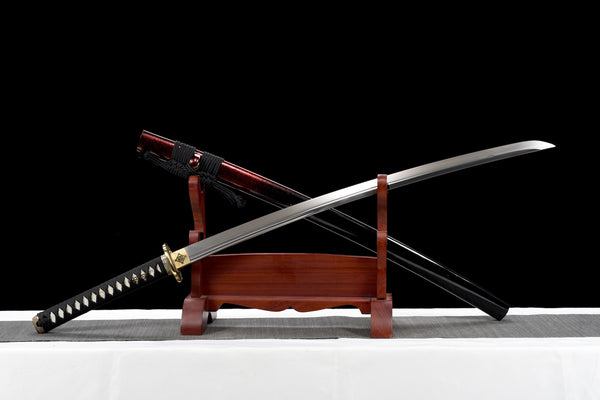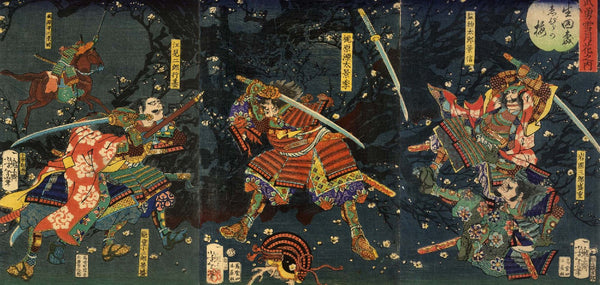How Heavy Is a Katana?
In Japanese history, culture, and martial arts, the katana, a legendary and iconic sword, has a significant role. The katana's weight, a delicate balance representing both use and symbolic meaning, is one of the main factors contributing to its attractiveness.
The katana's weight adds to its illustrious reputation as a deadly and expertly manufactured Japanese sword. Katana is not a light sword. A traditional katana typically weighs between 1-1.5KG (2-3 pounds). However, the sword's weight might vary depending on the blade length, steel type, forging technique, etc.
The weight of a katana plays a pivotal role in its functionality and overall performance on the battlefield. In this article, I'll discuss how heavy a katana is generally, along with some other information that might be helpful for you.
Table of Content
- The Average Weight of Katana
- Katana weight compare with other swords
- The Katana Weight Throughout History
- Weight & Balance of Katana
The Average Weight of Katana

Although there are no strict guidelines, katana weight should be between one and five kilograms. The average weight of katana is 1.2 kg. On top of it, the sheath (saya) brings an additional 100 to 200 grams. However, a katana's weight might vary according to the material and the user's preferences on their custom katanas.
Katana weight compare with other swords:
| Sword Type | Average Weight (kg) |
| Japanese Katana | 1.5 |
| European Longsword | 1.5 |
| Scottish Claymore | 2.5 |
| Arabian Scimitar | 1.0 |
| Chinese Jian | 0.8 |
| Indian Talwar | 0.9 |
The historical setting, forging methods, variances in design, and intended function are only a few variables that might affect katana weight on average. Now, let's discuss some of the main factors that affect katana weight:
Historical Era
The weight of a katana might vary depending on the era in which it was made because the swords were present over a long period. Because of cruder forging methods and the usage of various materials, earlier katana swords may be a little heavier.
Blade Length
The length of the katana's blade (nagasa) plays a role in determining its weight. In general, longer blades have greater mass and may weigh slightly more than shorter ones. The weight frequently changes while forging to keep the appropriate balance and feel.
Forging Techniques
Swordsmiths utilize diverse forging procedures to make traditional katana swords, which affects how heavy they are. Different blade portions are heated and cooled in various ways during the "differential hardening" or "clay tempering" process. It produces a blade with varied hardness and flexibility. So, it has an impact on the blade's weight distribution.
Steel Types
The type of steel used in forging the katana can significantly influence its weight. Different steel forms, such as Tamahagane or contemporary steels like carbon steel, spring steel or T10 steel, have varying densities and affect the overall weight.
Handle & Fittings
The materials for the handle (Tsuka) and fittings (Koshirae), such as the guard (Tsuba) and pommel (Kashira), can add to or reduce the weight of the katana. These can influence the overall weight of the sword. The katana would be less heavy if the fittings were lighter materials like brass or copper.
Tapering & Thickness
The katana's tapering shape, where the blade gets narrower as it moves toward the tip, impacts the weight distribution. The precise geometry and thickness of the sword affect the balance and overall weight.
Intended Use
The weights of katanas might vary depending on their intended use. A more balanced weight for effective cutting and mobility may be present in swords for actual combat usage. On the other hand, ceremonial or ornamental katanas can emphasize appearance more than performance, increasing their weight.
The Katana Weight Throughout History

As a result of many historical, technological, and cultural considerations, katana weight has changed over time. Here is a chronology of katana weights in general, showing how this changed from the beginning of development to more current times:
Pre-Heian Period
Swords in the early days of the katana's evolution were often heavier and needed more sophisticated designs of later times. People made straight, double-edged swords with moderately hefty blades, known as "Chokuto," during this time. The usual weight of a Chokuto is between 1.5 and 2.5 kilograms.
Heian Period
The progressive change from straight blades to the curved shape that characterizes the katana occurred during the Heian Period. During this time, katanas' typical weight, which had previously ranged from roughly 1.2 to 2 kilos, started to drop. But because of disparities in skill, there were still weight variations.
Kamakura Period
The start of the katana's distinctive design and peak development during the Kamakura Period are notable events.
In the Kamakura period, more refined blades with a narrower weight range resulted from technological developments in steel production and forging processes. During this time, the average weight of a katana was between 1 and 1.5 kilograms.
Muromachi Period
Katanas became progressively lighter and more balanced during the Muromachi Period as forging techniques advanced.
The standard weight of katanas during this era was a bit lighter than the previous times, and as a result, they were more handy.
Edo Period
During Japan's relatively peaceful Edo Period, the emphasis switched from military application to aesthetics and creativity. At this time, katanas were frequently lighter and more dazzling.
Modern Times
The traditional use of katanas in combat decreased when Japan entered the Meiji Period and beyond, and they shifted to a more symbolic and ceremonial role.
The average weight of modern katana copies and reproductions, whether made with conventional techniques or modern materials, is around 1 kilogram.
Weight & Balance of Katana
A katana's weight significantly impacts its balance, affecting its performance in combat or training. Its well-balanced construction, which features a center of mass placed strategically and appropriate weight distribution, increases the usefulness of a katana as a flexible and lethal weapon.
The point along the length of the blade where the weight distribution is uniform is called the center of mass. The best location for the center of mass of a katana is usually a few inches above the guard (tsuba). Feeling balanced while attacking and defensive movements from this position is possible.
Furthermore, the katana's responsiveness to direction, speed, and momentum modifications depends on its weight distribution. If the katana has a balanced center of mass, it allows for quick, accurate movements, making it more straightforward for the swordsman to use varied cutting methods.
Additionally, since the weight distribution is equal, a well-balanced katana is more comfortable to hold and causes less stress on the wrists and arms over time. The swordsman gains confidence and control from this balanced feel, which enhances their capacity to react to various battle situations.
Conclusion
The katana's weight embodies a harmonious union of creativity, usefulness, and profound significance. By now, you've got to know the necessary information regarding the weight of this historical sword. Thanks for reading through. Hopefully, you've found this article helpful. Good luck!





















